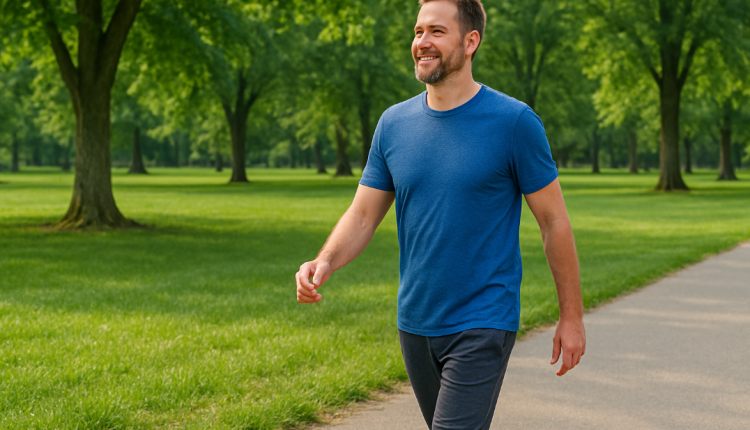In a world dominated by high-intensity workouts and step-counting challenges, the simplicity of walking often gets overlooked. Yet, walking remains one of the most accessible and effective forms of physical activity. Particularly for those in middle age and beyond, incorporating even short walks into daily routines can significantly reduce health risks and improve overall well-being. Recent studies have emphasized that even walking for as little as three minutes after meals can lead to substantial health benefits, making this modest activity a powerful tool in preventive healthcare.
The Science Behind Walking
Walking is a low-impact, moderate-intensity aerobic activity that engages the cardiovascular system, supports musculoskeletal health, and promotes mental clarity. Its benefits are not confined to long treks or high step counts. Research now shows that breaking sedentary behavior with short bursts of walking—especially post-meal walks—can aid digestion, stabilize blood sugar, and enhance cardiovascular function.
The body responds positively to movement, and when walking becomes a regular habit, it initiates a cascade of physiological improvements. These range from improved circulation to more efficient metabolism and stronger joints. Walking doesn’t require gym memberships, special equipment, or athletic prowess—just a commitment to regular movement.
Post-Meal Walking: A Game Changer
One of the most compelling findings in recent years concerns the benefits of walking for just three minutes after eating. This practice has been shown to significantly reduce blood glucose spikes, which are common after meals. For individuals over the age of 40, whose insulin sensitivity may naturally decline, these brief postprandial walks can be a critical strategy in managing blood sugar levels and reducing the risk of type 2 diabetes.
Short walks after meals stimulate muscular activity, particularly in the legs, which helps utilize glucose more effectively. This reduces the need for insulin and lowers the burden on the pancreas, making it especially beneficial for prediabetics or those managing metabolic syndrome.
Walking and Cardiovascular Health
Walking has long been associated with heart health, but short-duration walking—such as several three-to-five-minute strolls spread throughout the day—can be just as effective as longer sessions. These short walks help maintain healthy blood pressure, improve cholesterol levels, and enhance blood vessel function.
For older adults or those with limited mobility, walking can also serve as a safe and manageable way to meet physical activity recommendations without the stress or risk of injury associated with more strenuous exercises. The rhythmic motion of walking helps stimulate circulation, reduce arterial stiffness, and even support healthy heart rhythms.
Mental Health and Cognitive Benefits
The psychological benefits of walking are equally profound. Walking helps reduce cortisol levels, the hormone associated with stress, and promotes the release of endorphins and serotonin, which improve mood and emotional resilience. Walking outdoors, in particular, provides added exposure to sunlight and nature, further boosting mental health.
For middle-aged adults, walking also supports cognitive function. Studies have shown that regular walking can slow cognitive decline, improve memory, and enhance executive functions such as planning and multitasking. These effects are particularly relevant as people age and begin to face increased risks of neurodegenerative conditions like Alzheimer’s and dementia.
Joint and Muscle Health
Unlike high-impact exercises that can strain joints, walking is gentle on the body. It helps lubricate joints and strengthens the muscles that support them, particularly in the hips, knees, and ankles. Regular walking can ease the stiffness associated with arthritis and prevent the muscle atrophy that comes from sedentary lifestyles.
For individuals in their 40s and 50s, walking serves as a vital means of preserving mobility and independence into older age. The act of walking engages the core, supports balance, and enhances flexibility—all crucial components of functional fitness.
Integrating Walking into Daily Life
Despite its simplicity, many people struggle to incorporate walking into their routines. The key lies in seizing opportunities for movement throughout the day. Here are a few strategies:
- Walk After Meals: Set a timer to remind yourself to walk for three to five minutes after each meal. This habit can be a game changer for metabolic health.
- Break Up Sitting Time: Stand and walk for a few minutes every hour, especially if you have a sedentary job.
- Use Walking Meetings: Whenever possible, hold meetings on the go instead of sitting at a desk.
- Park Further Away: Choose parking spots that require a short walk to your destination.
- Stroll While Talking: Take phone calls while walking to combine productivity with health benefits.
A Lifelong Habit with Lasting Impact
Walking is more than just a form of exercise—it’s a sustainable lifestyle choice that promotes longevity and quality of life. Its adaptability makes it suitable for people of all ages and fitness levels. Whether you’re taking a leisurely stroll through the park, a brisk walk around the block, or a strategic three-minute jaunt after lunch, every step contributes to your health.
In a culture obsessed with quick fixes and extreme fitness, the humble walk offers a balanced, science-backed approach to wellness. By embracing walking as a regular part of daily life, individuals can enjoy improved physical, mental, and emotional health, with benefits that compound over time.
Conclusion
Walking remains one of the most powerful yet underrated tools in the pursuit of better health. Especially for those in their 40s and beyond, establishing a routine that includes short, regular walks—particularly after meals—can significantly reduce health risks and improve quality of life. It requires no equipment, no training, and no gym membership—just the willingness to take that first step. As research continues to support the profound benefits of even a few minutes of walking a day, there’s never been a better time to put one foot in front of the other and walk your way to wellness.
- Advertisement -

